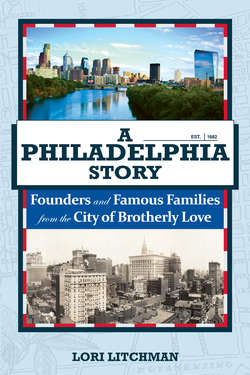Читать книгу A Philadelphia Story - Lori Litchman - Страница 11
На сайте Литреса книга снята с продажи.
The Grid System Is Born
ОглавлениеHAVING LIVED IN LONDON and seen the destruction that disease and fire could wreak on a city, Penn wanted his city to be safe. He hired Captain Thomas Holme to be his surveyor, and after scouting out the territory, Holme chose to lay out the city about a mile from the Delaware River, from today’s South Street to Vine Street. According to historian Russell Frank Weigley, the area was a hardwood forest covered in oak, black walnut, chestnut, cypress, hickory, beech, and elm. When Penn arrived, however, he felt that the area Holme had chosen was too small, so Penn moved his city westward. Penn decided that his Philadelphia should be situated between the Delaware and the Schuylkill Rivers, so he bought a mile of land along the Schuylkill. Philadelphia would be a total of 1,200 acres and would be 1 mile wide and 2 miles long.
Penn’s early vision for his “greene countrie towne” was to create large swaths of land for each purchaser. He imagined that each property would contain “gardens, orchards, and fields” and would be 800 feet apart from the neighboring lot. In his revised plan in 1682, Penn created somewhat smaller lots and laid them out in a rectangle. He reserved parcels of land to the north and west of Philadelphia (today’s North and West Philadelphia) and called those areas “liberty lands.” Penn originally intended to build a home for himself in today’s Fairmount section of the city, overlooking the Schuylkill River, but he would later decide to build his homestead, Pennsbury Manor, in what is now Bucks County.
Thomas Holme’s original layout of Philadelphia, 1683
(Via Wikimedia Commons, public domain)
Holme drew up Penn’s plan, which would later become known as a grid system. Both High Street (today’s Market Street) and Broad Street would be 100 feet wide and intersected by east–west running streets. Penn named those streets after trees: Cedar (today’s South Street), Pine, Spruce, Walnut, Chestnut, Mulberry (today’s Arch Street), Sassafras (today’s Race Street), and Vine. The north–south streets were numbered, as they remain today.
Penn also created space for four sections of land that would be designated as park space open to the public. Today, those parks are known as Franklin Square, Logan Circle, Rittenhouse Square, and Washington Square. Penn designated the home of the city’s current City Hall as the center of town and home to the Quaker meetinghouse, school, market, and state center. With that, the grid system for cities was born, and as urban areas developed across the country, they would often use Penn’s system as a blueprint.
